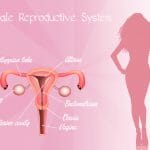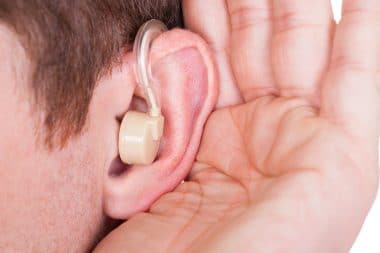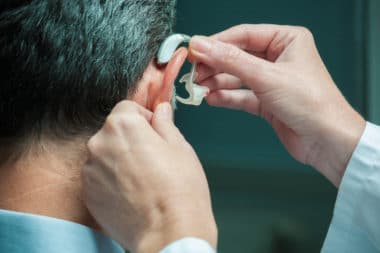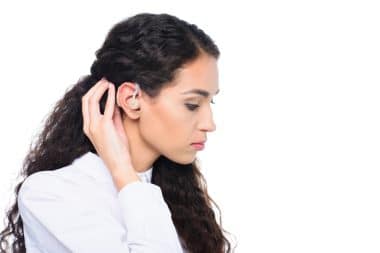Most people think of ears as small receivers that just catch sound so we can hear, but hearing is actually more complicated than just catching sound. Ears are amazing organs with several different places to receive sound and send signals to your brain. Your other senses, like taste and smell, rely on chemical signals from your taste buds or olfactory bulbs to communicate with your brain, but hearing is an entirely mechanical process. That is, only the movement of physical structures of the ear are necessary to hear.
This article will walk you through the physics of sound waves and the physical components of the ear that deliver sound to your brain. You’ll find out how the parts of the ear work together, how to protect your ears, and ways things can go wrong with this system and cause hearing loss.
What is Sound?
Hearing starts with sound, but what IS sound anyway?
Sound is the vibration produced when an object moves. There are big sounds, such as trucks driving past and small sounds, like gas escaping into the air. Our ears can’t hear every type of sound, but even when we can’t hear it, every time matter moves in space, a sound is produced.
When an object moves, it displaces the air around it. All those air particles push and slam into the air particles next to them, and move back into their original place. Those pulsing bumps of one air molecule colliding into the next move through the air as a change in pressure that increases, then returns to normal. Imagine a crowded hallway, and as one person near the end stumbles, it sends a ripple of movement down the hall as each person takes a small step back and into the person behind them, and then steps back into their original place.
This ripple, or pulsing movement is a wave of pressure that moves through the atmosphere away from the moving object. Different objects make different kinds of sounds as they move or vibrate because they exert different kinds of air pressure. Remember our people in the hallway? If a very large man tumbles backward at the end of the hall, the ripple of movement will be much larger than if a small child tumbles. The same variation happens with sounds.
Technically speaking, sounds vary in the frequency of the sound wave. Just like ocean waves, that push and pull of air pressure has a crest and a low. Higher frequencies means the air pressure ripples between that crest and low very quickly. Our ears perceive high frequencies as higher pitched sounds. Lower frequencies have fewer crests and lows over time and sound lower pitched to our ears. So the frequency of the sound wave impacts the pitch of the sound we hear.
There’s one more element of sound waves that is helpful to know: volume. Sounds waves also have amplitude, or a level of air pressure. A high amplitude sound wave has higher crests and lower lows than a low amplitude wave, which might not have much difference between its highest and lowest points. We hear high amplitude waves as loud sound, and low amplitude waves as soft.
Now you understand the physics of sound waves. Next, let’s look at how the ear gathers those waves and makes sense of the frequency and amplitude.
Read all our articles on hearing. CLICK HERE
Hearing is more interesting (and complicated) than you thought! Find out how: #HealthStatus
Key Points
- 1Hearing results when sound waves move through the canals of the ear to vibrate the ear drum and hair cells.
- 2Hearing loss can be caused by age, or preventable damage to the inner or outer ear.
- 3Hearing aids may be the best choice for compensating for many types of hearing loss.
Effective Ears
The outer ear
The ear is made up of three chambers: the outer, middle, and inner ear. The outer ear, or pinna, is the sound catcher. Its broad, cup-shaped curves channel sound into the much narrower ear canal. Higher pitched sounds, especially, are amplified by the narrow, tunnel shape of the ear canal. At the end of the canal, sound vibrations physically connect with the ear drum, causing a mechanical vibration.
The middle ear
On the other side of the ear drum, within the middle ear, the vibrations now physically move three tiny bones that enhance sound in a chain reaction. The stapes, a stirrup shaped bone at the end of the chain, is attached to a thin membrane called the oval window. This membrane is the barrier to the inner ear, a fluid-filled space called the chochlea.
The inner ear
The inner ear is, not surprisingly, inside the skull. The cochlea is a curled tube that resembles a snail shell and is lined with special sensory cells on a flexible membrane. Each time the stapes vibrates the oval window from the middle ear, those sensory cells move.
Sensory cells
Sensory cells may not sound that special. After all, we have millions of cells in our bodies, right? But the sensory cells of the inner ear include two kinds of hair cells that performs very special roles in the hearing process. Outer hair cells make soft sounds louder and loud sounds softer. This attenuation keeps your brain from missing things that are too loud or soft by keeping the vibrations within the range that your brain can interpret. The other major cochlear sensory cells are inner hair cells, which do the final mechanical stage of hearing: transferring all the vibrations to the auditory nerve. Once there, sound information moves through several parts of the brain to be decoded and translated into a meaning.
How Hearing Changes
People experience hearing loss from many different sources. Some hearing loss is due to natural aging of the ear, while others are preventable or temporary conditions. Learning about common causes of hearing loss can help you know how to best care for your ears at every age.
Conductive Loss
Blocked ears can interfere, or alter the chain of physical vibrations that transfer sound from the outer ear to the auditory nerve. Ear wax that builds up in the ear canal can make sound muffled, and reduce the frequencies that can make their way to the middle ear. Most ear wax works its way to the outer ear where people can safely clean away wax with regular use of a soft wash cloth, but wax that is inside the ear canal should be removed only by an ear specialist or Audiologist. Remember: never stick anything in your ear that is larger than an elbow. You may accidentally make the hearing problem worse by damaging the ear canal with a cotton swap or other inappropriate tool.
An ear infection, or otitis media, is a condition where fluid builds up in the middle or inner ears behind the ear drum, putting pressure on all the membranes and reducing their ability to move and vibrate to transmit sound. Not only is this pressure usually quite painful, but many people notice temporary hearing loss that accompanies common ear infections. The general recommendation is to treat the pain of ear infections with over the counter pain relief medication and allow the infection to resolve itself in the course of a few weeks. If your ear has yellow or green discharge, or an odor, a physician may need to prescribe you antibiotics to resolve the problem. Never use ear candles, garlic oil, or other natural remedies that require putting foreign materials into the ear canal- this will only introduce more bacteria into the infected area, and can cause more damage, even leading to permanent hearing loss.
Rarely, the bones in the middle ear may experience abnormal growth and the stapes can become too tightly connected to the oval window. With such a tight bond, sound vibrations aren’t fully transmitted, resulting in some hearing loss. This condition, called Otosclerosis, will not resolve on its own. Caught early, it can sometimes be reversed through surgery, but patients may need to use a hearing aid if they experience this kind of conductive hearing loss.
Sensory Loss
Unlike conductive loss that results from interruptions or limitations on the physical vibrations of the ear structures, sensory hearing loss takes place when the inner and outer hair cells of the cochlea are damaged. This may or may not accompany conductive loss, and is often a permanent change to hearing.
Changes to the outer hair cells are a natural part of aging. Most people in their 70s and 80s only have about 70% of these sensory cells still intact and often become hard of hearing. Remember that outer hair cells attenuate sound, helping you hear soft sounds and protecting you from loud ones. The effect of having less outer hair cells in the cochlea are primarily a loss of that amplification of high pitches. Many elderly people who are bothered by this hearing loss work with professional Audiologists to get a hearing aid specialized to amplify high frequency sound waves and return some of those high pitched sounds.
While outer hair cells naturally deteriorate with age, even very young children can damage these sensory cells when the ear is exposed to excessively loud noises. In older people, loud sounds can accelerate the ongoing deterioration and cause hearing loss to happen faster. Protect your ears from noise damage by wearing appropriate hearing protection such as special headphones designed for firing rifles or using loud construction tools. Small, discrete ear plugs are available for going to loud concerts or sporting events. Unfortunately, hearing loss due to damage to the outer hair cells from noise exposure is not reversible, and hearing aids may be necessary to compensate.
Inner hair cells can also be damaged from excessive noise, as well as disease or degenerative conditions. Like outer hair cells, these sensory connectors do not regrow over time, so damage to an inner hair cell will result in permanent hearing loss. The outer hair cells carry on the chain of mechanical vibration of sound in a physical way, but the inner hair cell has to deliver the vibration to the auditory nerve, and begins to involve the brain in the process of hearing. Because of that special link, hearing loss cause by damaged inner hair cells may not be helped by traditional hearing aids and may require cochlear implants to regain functional hearing.
Extraordinary Ears
No matter what your age, and no matter what kinds of sounds you like best, the incredible design and physical structures of the ear enable us to translate sound waves from the air into meaningful information in our brain. Knowing how the process works can help you protect those delicate structures and preserve your hearing as long as possible. If you or someone you love is hard of hearing, don’t wait: see a professional audiologist and ask about options to compensate and regain this vital and fascinating sensory experience.








Reply